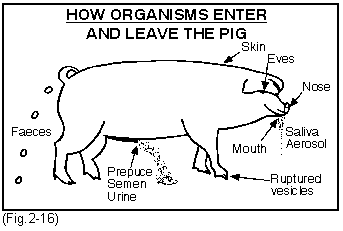



Spread of disease by direct contact between pigs
Infectious agents enter and leave the pig as shown in (Fig.2-16).

The common methods are by mouth (ingestion) or by inhalation. In general inhalation requires smaller doses of the organism than ingestion to set up an infection and produce disease because the acidity of the stomach and the normal bacterial flora of the intestines inhibit the multiplication of the organisms. Even smaller doses are required if infected material is splashed into the eyes. Some organisms, notably leptospira, can penetrate the mucous membrane lining the mouth and lips. Infections may enter the body through skin abrasions (e.g. erysipelothrix) and some may multiply in and on the skin (e.g. staphylococci causing greasy pig disease). Infections may also enter at mating either via the semen and seminal fluids or mechanically from the boar's prepucial sac, which is heavily infected with bacteria, or contamination. The penis may contaminate the vagina from the females dirty vulva and surrounding area.
Within the pig different infections multiply in different organs, enteric pathogens in the gut, respiratory pathogens in the respiratory tract, leptospira and some viruses in the kidneys, etc. and some become generalised and multiply throughout the body. The route by which the pathogen is spread will depend on the organs it has multiplied in.
Many live in faeces, some in the urine (e.g. leptospira) in vaginal discharges, semen, the skin. saliva, nasal discharges and expired air.
The main method of spread of respiratory diseases is by airborne droplet infection. The transmission of diseases by droplet spread in the air, is often restricted to as little as 10 metres but under the right climatic conditions can be many kilometres. Where pigs are in the same environment and particularly when in the same pen, or where the pens are separated by railings, organisms will be transferred by direct body or nose to nose contact. Whether clinical disease develops or not is dependent upon a number of factors including:
The resistance of the pig to the infection.
The survival of the organism outside the pig.
The virulence of the organism.
The numbers of the organisms to which the pig is exposed.
Spread of infection may be within or between herds and between countries. The reader is unlikely to be involved in the third of these so this section will concentrate on the first two, particularly the second.
The ways in which infectious diseases spread within farms are similar to those by which they spread between farms except that the relative importance of each is different. In spread within farms, rodents, flies, equipment and airborne dust and aerosol are more important.
There are also additional modes of spread within farms that are unlikely between farms. Often slurry or solid manure is moved or drained between pens which have a common defecating alley, and there is direct contact between pigs within pens and often between pens. Even if there is not direct contact between pens, infections, including intestinal infections, can move in the dust-laden air. The respiratory tracts of the pigs act as vacuum cleaners, removing the dust from the air, sticking it against the mucus of the respiratory tract and moving it to the throat by the mucus elevator so that it can be swallowed. This commences from birth. Thus newborn piglets take their first breath, inhale E. coli and introduce the bacteria to their intestines.






